Treasure of the Kalkalpen National Park
The wild forest
Especially natural forests are primeval forests because they have remained completely untouched by humans since the reforestation after the last ice age! Apart from the Rothwald forest in the Dürrenstein-Lassingtal wilderness area and the Neuwald forest on the Lahnsattel in Lower Austria, there are only small remnants of them left in Austria. In Kalkalpen National Park , remnants of primeval forest have survived to this day behind rugged gorges and in hidden valleys. They are core areas of unimagined diversity, genetic reservoirs and the backbone of the national park.
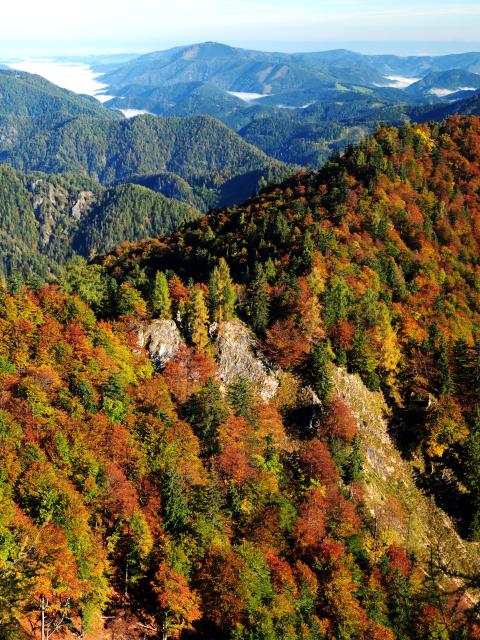

Backbone of the Kalkalpen National Park
primeval forest
As part of the biotope mapping, eight forest areas have been discovered in inaccessible locations that are very likely to be classified as remnants of primeval forest. These are predominantly beech and spruce-fir-beech forests, with small areas of natural spruce forests. The total area of the primeval forest remnants covers slightly more than 37 hectares, the smallest area is only slightly larger than two hectares, the largest covers around 14 hectares. (Lenglachner & Schön 2008)
As the forest in the Kalkalpen National Park is left unused, over time it will increasingly resemble primeval forest with its mighty giant trees and abundance of deadwood. The "birth" of a (secondary) primeval forest is in full swing!
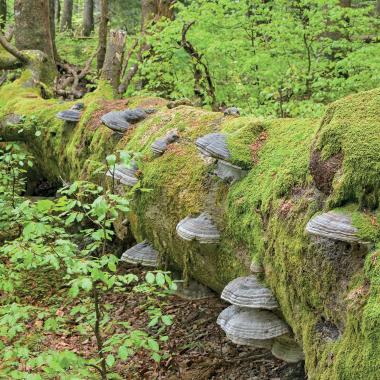
Anything but dead
Deadwood
Around a third of all forest organisms are directly or indirectly dependent on deadwood!
Deadwood refers to dead trunks and branches. It is a habitat and food source for a large number of living organisms in the forest. Due to the large-scale and intensive use of forests in commercial forests, many of the creatures that use deadwood have become rare.
The National Park Forest currently has an average of just over 30 solid cubic meters of deadwood per hectare. This is more than three times the average for the whole of Austria's forests. Not only the quantity, but also the quality of the deadwood is crucial. Many of the endangered forest species need deadwood with a diameter of over 20 cm to survive. Deadwood users include many species of fungi, beetles, owls and woodpeckers, mammals such as the dormouse and bats, as well as lichens and mosses. The best known of these are probably the beautiful Alpine longhorn beetle or the rarest woodpecker in Austria - the white-backed woodpecker.
In the best
forest community
There are 30 different forest communities in the Kalkalpen National Park
The spruce-fir-beech forest dominates the landscape. For centuries, the forest was the most important supplier of energy and raw materials. Its use has changed it in many ways: The proportion of spruce and larch has increased at the expense of fir, beech and other deciduous trees.
And yet there are still near-natural forests in the national park. They are the nuclei of a contiguous natural forest of tomorrow. Diversity is emerging again in the national park. Trees are allowed to grow, grow old and die, just as nature intended. Old, dead trees are an important habitat for many animals such as beetles and woodpeckers. While the next generation of trees grows on decaying trunks, insects and microorganisms decompose the remains of the dead wood into fertile humus.
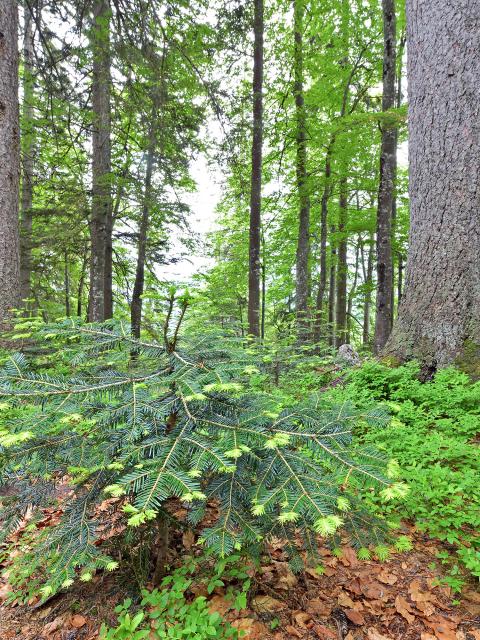
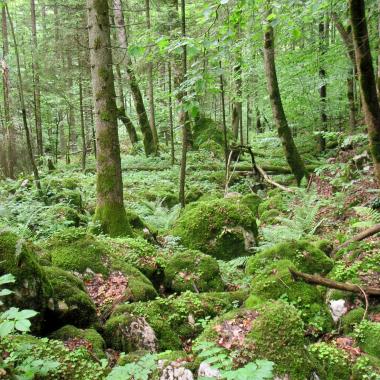
Mixed ravine and slope forests
On slopes and in ravines with high humidity, a constant good water supply and a certain instability of the soil, mixed forests rich in precious woods can be found. The tree layer is generally very species-rich and consists of maple and lime species, ash and mountain elm. These forest stands are rather small in the national park and only cover a few hectares. The tree trunks often show sabre growth due to the unstable slopes. A shrub layer is generally present, while the herb layer is usually dominated by broad-leaved, tall-growing shrubs. As the leaf litter is decomposed within a few months, ground mosses can develop abundantly. Many of the stand-forming tree species have a high potential for vegetative regeneration, such as stem suckering and root suckering.
In the national park, this type of forest is predominantly found on lower slopes above thin gravel bodies as a deer-tongue formation of the ash-maple forest along larger river valleys. There is a very rare formation with a gall beard in the Bodinggraben. In addition, there are tiny thermophilic fragments of lime forest in the Blumaueralm and Zeckerleiten areas, scattered hazel scrub fragments as a permanent community and small areas of maple-elm forests.
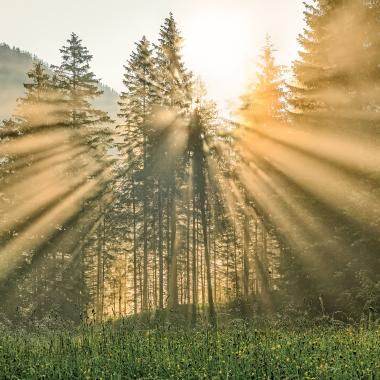
Montane to alpine acidophilous spruce forests
The habitat type comprises different forest communities, all of which are dominated by spruce. On the one hand, these are the coniferous forests of the Alps and low mountain ranges in the montane to alpine altitudinal zone over silicate and carbonate rock. On the other hand, spruce is found in Central Europe on special sites such as boulder slopes and rocky outcrops or in cooler local climates. Spruce is a particularly cold-resistant tree species that can withstand winter temperatures of minus 40 degrees Celsius. Natural spruce-dominated forests in Central Europe are characterized by climatically long, cold winters, regular late frosts and thus a short growing season. Almost everywhere where spruce grows in pure stands, it creates the conditions for the formation of raw humus with its poorly decomposable needle litter. Typical character species of spruce forests are therefore acid indicators. In the montane altitudinal zone, the spruce often forms closed, sparsely-graded stands. Towards the tree line, the forests become increasingly loosened and stepped. Here, the spruce trees occur in a low, narrow-crowned high-altitude form and grow in groups.
Acidophilous spruce forests can be found in the national park in small areas over acidified ridges, such as in the Alpkogel-Rabenplan area or in sinkholes, for example in the Kollersgraben. It also grows as a tall shrub variant in the Alpstein-Trämpl-Nordhang area, in the north and east of the Größtenberg and in the Feichtau-Sonntagmauer area.

Bog forests - small-scale and very rare
Bog forests comprise the shrub and forest communities over wet, acidic peat soils. Woody vegetation usually develops on the edges of bogs. In a climate with less precipitation and under appropriate soil conditions, the forests can also cover the entire moor. In general, bog forests are dominated by birch, red pine, mountain pine or spruce. Due to the extremely poor conditions of the peat soils, the trees grow to a maximum height of 20 meters or remain shrubby. The stands are loose and patchy, only shrub communities are very dense ("mountain pine felt"). The trees grow slowly and are nowhere near the heights, ages and diameters achieved in other forest communities. The ground vegetation of bog forests comprises the shrub and forest communities over wet, acidic peat soils.
In the National Park, they can be found in the Ebenforst, Rotwagmauer, Dörflmoaralm and Feichtau areas, all of which belong to the spruce-dominated moorland forests.
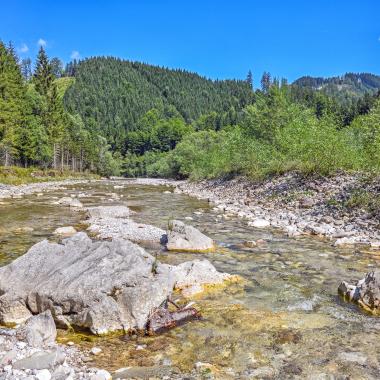
Riparian forests with black alder and noble ash
Alder and ash riparian forests develop in the immediate flooding areas of watercourses and in locations with regularly fluctuating, high groundwater levels. They consist of fast-growing woody plants whose roots are in contact with the groundwater all year round.
The floodplains flooded by stronger floods are more likely to be colonized by willows. These are very dynamic habitats. In the planar to colline altitudinal zone, black alder and noble ash grow on waterlogged, clayey substrates along low-gradient streams and rivers. The stands can take the form of narrow strips of woodland along streams, but can also be extensive forests that cover the entire floodplain.
The canopy is usually not completely closed, which allows a lush herb layer with tall perennials to develop. The shrub layer also often grows luxuriantly. At higher altitudes, gray alder-ash or ash forests develop.
In Kalkalpen National Park there are gray alder meadows on broad alluvial soils, especially along the Großer Bach in the Hintergebirge, on the Krummen Steyrling in the Bodinggraben and on the Blöttenbach. Spring ash forests grow on the eastern slope to the Große Klause, locally above Lunz layers on the northern slopes (Jörglgraben).



